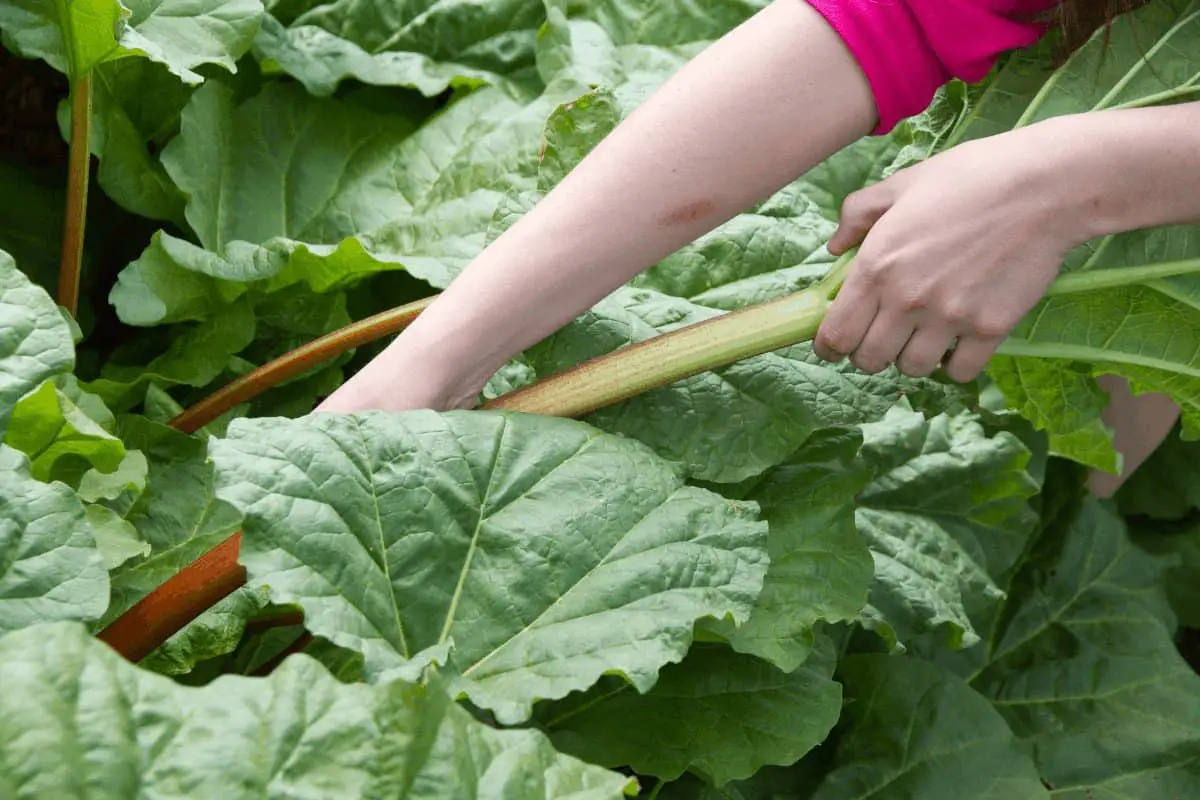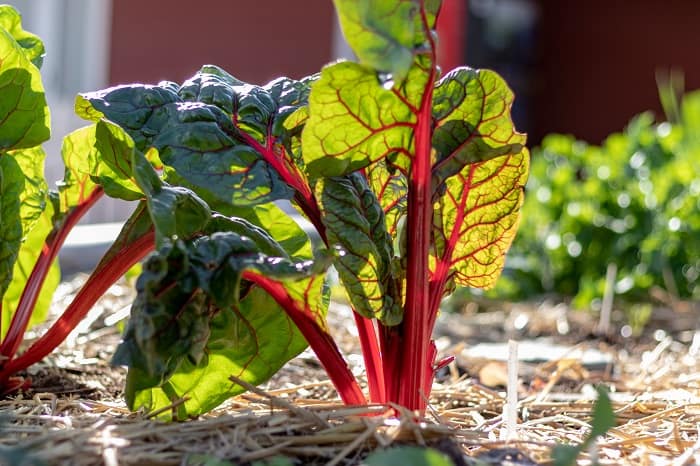Last Updated on December 29, 2021 by
Rhubarb is one of the most unique vegetables as people often pick and use it in the same manner they would a fruit. For example, most people don’t bake carrot pie, but it is common to see strawberry rhubarb pie, jams, jellies, and other goodies. This herbaceous perennial is a favorite among individuals in temperate zones because of its high growth rate and ability to be harvested at almost any time of the year.
However, just because you can pick rhubarb whenever you want doesn’t mean you should. There are several times of the year when rhubarb tastes it best and the base plant will be alright after you’ve taken some stalks for cooking. This guide seeks to answer the age-old question, then, of “When is rhubarb ready to pick?”. Read on to find out more.
When Is Rhubarb Ready to Pick?
Before you pick rhubarb, you need to know which parts you can eat and which is bad for you. In general, humans should only eat the fleshy stalks and need to avoid the leafy greens. Rhubarb is notorious for containing oxalic acid, which can wreak havoc on the kidneys and lead to poisoning. While the stalks contain a small, healthy amount, the leaves have enough to make a person sick and induce vomiting and stomach discomfort. Someone who decides to sit down and eat 4-8 kg. of leaves could even kill themselves by accident, so don’t try to make any rhubarb leaf salads!
With this in mind, the stalks are perfectly safe to eat and can appear in a broad range of colors, including red, pink, and green. When you harvest, make sure to only grab these and remove any leaves carefully before preparation.
When to Harvest
One of the most interesting characteristics of rhubarb is how it can be considered ripe at almost any point throughout the spring and summer. It just depends on how sweet, sour, or bitter you want the rhubarb to be and what you intend to use it for. However, if you want to keep the plant healthy, there are certain points in the growth cycle when the rhubarb is ripe for the plucking.
Because rhubarb grows multiple stalks, it is important to only harvest the ones that are strong enough to survive being removed from the central stem. The ideal length of the leaf stalks is around 10 in. long, as the stalk will be healthy and the central stem will not be adversely affected
It is also important not to start harvesting your rhubarb come fall. While it is possible to do so, your plant needs time to store much-needed energy for winter. Picking up until the first frost is a good way to kill a younger, weaker plant. Also, don’t harvest any rhubarb during the first two years after planting. It isn’t ready and could wither away and freeze in winter.
How to Harvest
The easiest way to harvest rhubarb is to simply pull the stalks away from the rest of the plant. When ripe, they should come away easily and will be ready to prepare. If the stalks are the right size but are not coming loose, then you can cut them free near the bottom of the plant using a pair of garden shears or scissors.
When harvesting from a central plant, it is important to start from the outside and work your way in. If some of the stalks seem short and thin, leave those for another day when they have the chance to grow a bit more. Try to leave at least ⅓ of the stalks on the plant during the spring and fall so the vegetable has enough time to store and utilize energy in the upcoming months.
Do NOT harvest up until the first frost, as this will lead to a dead plant. At the same time, don’t pick too many in the summer either, as the vegetable doesn’t like the heat and is not a big summer grower.
Finally, once rhubarb has begun to flower, it becomes more difficult to pick. If you are worried about the flowers hardening the stalks, you can cut away the bulbs to enjoy more time with your sweet prize. Just remember to dispose of the leaves as well.
Varieties of Rhubarb
Before you pick your rhubarb, it’s a good idea to know what you have planted. Contrary to popular belief, there is more than one type, and each one has a slightly different growing season and maturation period. At the moment, botanists tend to distinguish between eleven varieties that all grow well in temperate zones. These are:
- Holstein Bloodred
- McDonald’s Canadian Red
- Canada Red
- Colorado Red
- Cherry Red
- Victoria
- Riverside Giant
- Turkish
- German Wine
- The Sutton
- Sunrise
These varieties are typically split between the ‘reds’ and the ‘greens.” The sweeter plants are the reds, which often range in color between dark pink and red. Greens, on the other hand, are hardier and better in cold climates but are more bitter. However, this rule is not standard. Some reds are extremely acerbic, while a couple greens like the German Wine tastes like fruit juice.
When determining whether or not your rhubarb is ready to pick, be sure to do some research about your plant. If you are unsure of what you have in the ground, examine the leafy part that protrudes above the soil. You should be able to match it to a local variety. If you still can’t tell, pull one of the vegetables early and compare the stalk to pictures of the eleven varieties.
Conclusion
Rhubarb is a versatile vegetable that can be tangy, sweet, and delectable depending on the time of year in which you collect the stalks. When picking rhubarb, it’s important to harvest during the spring and fall and to allow the plant enough time to gather and store energy for the summer and winter. Remember to only take big, healthy stalks, and always dispose of the leaves in the garbage or compost bin to avoid that oxalic acid. Your stomach and taste buds will thank you!
FAQs
How can you tell if rhubarb is ripe?
There are three common signs to tell when rhubarb is ripe and ready to eat - Its leaves change color, its stem becomes more flexible, and the skin on its fruit becomes wrinkled.
When should you not pull rhubarb?
If you see leaves or green on your plants, it is still safe to pull rhubarb. As a general rule of thumb, if the fruit are turning red, it might be a little past the prime time for pulling them off the plant.
Is it better to cut or pull rhubarb?
The most effective way to cut it is to cut it as close to the stalk as possible.
If you’re pulling, try to hold down and steady the stalk while you pull from the top down towards your hand. This will ensure a cleaner cut!
Does rhubarb spread on its own?
In a garden, rhubarb can take over and overtake all the space in a very short time. It might be difficult to remove it from the garden and keep it from spreading.
Having said that, it is not necessary to destroy rhubarb plants to stop them from spreading. They might spread on their own if given enough room but some gardeners might want to help out with this process and resist the spread of rhubarb by planting another type of plant nearby that belongs in its place.
What month should you stop picking rhubarb?
Rhubarb is a delicious and popular seasonal fruit that most people enjoy. It is also a difficult plant to grow and harvest, but the rewards make it worth the effort.
According to the University of Minnesota Extension, rhubarb should be picked in early spring from March to May when temperatures are consistently above 45 degrees Fahrenheit.
Why is my rhubarb floppy?
Rhubarb has a tendency to have floppy leaves in the late summer and fall. It is caused by the plant's inability to transport water from the root system to its leaves.
This condition can affect your plants if you are not careful, so it is important take care of your garden. This includes providing adequate drainage and watering your plants for the best rhubarb results possible.
Should I remove yellow leaves from rhubarb?
The color of rhubarb leaves can be affected by the amount of sun the plant gets. In some cases, the leaves start to turn yellow and eventually die and fall off. But in other cases, they can stay on.
The leaves might not turn yellow or fall off after all if you remove them. However, if they do turn yellow, you can remove them with ease by cutting away at their base with a sharp paring knife or vegetable peeler.
You should remove any yellow leaves from your rhubarb plant as soon as they show up in order to prevent any further harm to it and avoid wasting food on plants that will ultimately die anyways.
What should not be planted near rhubarb?
Planting vegetables or flowers near rhubarb plants can cause a smell that will affect the entire house. It is also important to keep in mind that rhubarb leaves are poisonous, so you should not plant anything near it without consulting with your local gardening store.
What should not be planted near rhubarb:
- Flowers: Roses, lilies, sunflowers, daisies
- Vegetables: Tomatoes, potatoes, celery
- Fruits: Apples
amzn_assoc_placement = “adunit0”;
amzn_assoc_tracking_id = “gardeningdreams-20”;
amzn_assoc_ad_mode = “manual”;
amzn_assoc_ad_type = “smart”;
amzn_assoc_marketplace = “amazon”;
amzn_assoc_region = “US”;
amzn_assoc_linkid = “e9451e4d426ac8be130262bfc12b29cc”;
amzn_assoc_design = “in_content”;
amzn_assoc_asins = “B0797CZR2X,1591930510”;
Tony Manhart is a passionate gardener who has been tending to gardens for over 20 years. He takes pride in creating beautiful outdoor spaces with plants, trees, and shrubs that can thrive in any environment. He loves to share his knowledge with others and has taught classes on gardening basics and advanced techniques. He is committed to sustainability, using natural and organic methods to create and maintain gardens. He also works with local organizations to create green spaces for communities. When he’s not gardening, Tony enjoys hiking, reading, and spending time with his family.




